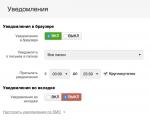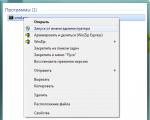How to set a notification when receiving mail. Notifications in the tab. Notifications are not received
“Mail settings” → “ Notifications»
Browser notifications
Browser notifications appear in the corner of the screen. They contain brief information about the received letter: the sender's name, subject and beginning of the letter. To go to the letter, click on the notification.
Browser notifications are only supported in Chrome 44 and later.
To enable browser notifications:
- Set the switch under Browser Notifications to ON.
- In the drop-down list, select the folders from which notifications will come. Click Select All to receive notifications from all folders.
- Select the time you want to receive notifications. Check the box next to “Around the clock” to receive notifications all day long.
- Click "Save".

To receive notifications in your browser, you must also enable this in your browser settings:
- On the mailbox page, click the padlock icon in the address bar.
- Set the Notifications option to Allow.

Notifications in the tab
Notifications in a tab come if you have Mail open, but you are working in another tab. In this case, you will hear a beep and see that the title of the Mail tab has changed.

Tab notifications are not supported in Internet Explorer and Microsoft Edge.
To enable notifications in a tab:
- Set the toggle under Tab Notifications to ON.
- Uncheck “Only for Inbox” if you want to receive notifications in the tab from all folders.
- Uncheck the “Sound notification” checkbox if you do not want notifications to be accompanied by sound.
- Click "Save".

Howard is a small email notification utility. Supports all popular email services. The program is designed as a background application that periodically checks the mailboxes specified in the settings and, when a new incoming letter is detected, will notify you with a sound signal and a pop-up message in the system tray.
Howard description of features
Howard makes it possible to forget about periodic manual checking of electronic mailboxes. The program will be useful especially for those who have two or more email addresses. The Howard utility, depending on the frequency set in the options, supports cyclic checking of new emails from 30 seconds to 2 hours.
For the program to work, you will need to select one or more email services and log in to the corresponding one under your account. Howard is not an email client and cannot open incoming emails itself. The application was created only to notify you of the receipt of new mail. As soon as Howard has detected a new incoming message, it will immediately notify you with a sound signal and a small message will appear in the taskbar area. By clicking on the program's pop-up window, a browser opens with the mail service website opening, or an email client, if you use it to read and send mail.

Howard supports email services:

The program settings are very simple and intuitive. In Howard's options, you can select the styles of pop-up notifications about received letters, change the sound signal and set the frequency of checking mailboxes.
If you have several mailboxes, you can receive notifications about new messages in Yandex.Mail to a different address. To set up notifications:
Click the icon in the top right corner.
Select Rules for processing letters.
Click the Create Rule button.
In the Apply block, select from the lists what type of emails you want to apply the rule to:
In the block If you set conditions for processing:
","hasTopCallout":true,"hasBottomCallout":true,"areas":[("href":"filter-glossary.html#filter-glossary__terms-attributes","shape":"circle","direction": ["top","left"],"alt":"Enter the value of the selected parameter","justMapLink":false,"coords":,"isNumeric":false,"hasTopCallout":true,"hasBottomCallout":false) ,("href":"filter-glossary.html#filter-glossary__terms-features","shape":"circle","direction":["bottom","right"],"alt":"How strictly should the condition is met","justMapLink":false,"coords":,"isNumeric":false,"hasTopCallout":false,"hasBottomCallout":true),("href":"filter-glossary.html#filter-glossary__terms- attributes","shape":"circle","direction":["top","right"],"alt":"Select parameter","justMapLink":false,"coords":,"isNumeric":false ,"hasTopCallout":true,"hasBottomCallout":false)]))">
For more information on how to correctly create a condition, see the special article.
For one rule, you can set several conditions that can be executed simultaneously or separately: 
In chapter Perform action enable the option Notify by address and specify the address to which notifications will be sent.
Check the mailbox you specified to receive notifications. You will receive an email with instructions on how to confirm receipt of notifications. After confirmation, messages about new letters will be sent to the specified mailbox.
Notifications are not received
This may be due to the following reasons:
Personal data is not indicated in Yandex.Passport
Indicate authentic ones in Yandex.Passport and link them to your account. Our security system may have found your account suspicious and blocked your mailbox. Most often, this happens due to the fact that the phone number is not attached to the box or the Passport contains a fictitious first and last name. It usually takes a couple of hours to remove the lock.
The rule is not activated or the address is not confirmed
Make sure that the desired rule is activated on the page, as well as the one to which the letters should be sent. Check for typos in the address you provided.
Not much time has passed since setting up the rule
After you have configured the rule, wait a few minutes - the rule may not work immediately.
Rule conditions are incorrectly specified
Check the properties and parameters of the condition.
There are higher priority rules in the list of rules
If in the list above there are rules with the same conditions or in one of the rules above there is an option Do not apply other rules, then this may affect the execution of the rule. For more details, see section
Despite the increasing spread of mobile Internet access, there are still many places where not only is there no Internet, but mobile communications barely work. If you are expecting an important letter, constantly checking your mail in such a situation turns into a real punishment. It is much more convenient to be able to receive a notification via SMS when you receive the desired letter. Below you will find out how to do this.
We bring you a detailed step-by-step guide through which you can receive SMS on your phone when you receive a specific or all emails in your Gmail inbox.
1. Open Gmail. Create a new shortcut called Send text. To do this, click on the link in the left panel Create a shortcut and enter the name.

2. Open Google Calendar and create a new calendar called Gmail. All letters will be marked here, the arrival of which will be sent to you by SMS. This is also a very useful feature.

3. Open Google Drive and create a new table with any name. In this table we open the menu Tools, there we click the item Collection of scripts.

4. B Script gallery we find a script called Gmail SMS alerts v.2. Click the button Install. Then close the gallery window.

5. Let's return to our table. Here on the menu Tools choose Script editor. The script we added for editing will open in a new window.

6. In the editing window, go to the menu Resources and select the item Triggers of the current script. In the pop-up window that appears, set the frequency of the script.

7. Save the script and run it for execution. We agree with the warning and allow the script to run.
8. Now we need to set the rules by which messages will be selected for notifications. To do this, you need to create a new filter in Gmail that will select messages based on a condition you specify, for example, from a specific sender or on a specified topic, and assign them the Send text label, which we created in the very first step. If you want to receive notifications about all letters arriving in your Inbox, then specify as a condition Contains words is:inbox.

That's all. If you did everything correctly, now when a letter that meets the conditions you specified arrives in your Gmail inbox, you will receive a notification on your mobile phone, and this event will be recorded in the calendar.
A colossal amount of information is exchanged around the world. People of all professions use it as a way to quickly convey data to the recipient. A significant share of this area is accounted for by various free services that offer quick registration, almost unlimited box size, and a convenient interface for working in a browser.
If you send and receive emails several times every day, it becomes necessary to display your email on your desktop. This will allow you to quickly access the mailbox without typing the address in the browser. You can also create a shortcut to send mail to a specific address.
How to display the mail icon on the desktop - in our new article
Using the web interface
In order to quickly access the web interface of the mailbox on any service, you can create a shortcut on the screen. Let's consider the procedure using the example of the Yandex service, as one of the most popular and multifunctional resources:
- Right-click on any free space on the screen and select “Create shortcut”.
- In the line that appears, enter https://mail.yandex.ru.
- Come up with a name, for example, “Yandex Mail”.

Such a shortcut will send you to the start page for logging into mail and, if you clicked on “Exit” during previous use, you will have to enter your login and password.
Instead of the specified link, you can copy the address bar of your browser when you are in mail. By analogy, you can display the creation of a new letter on your desktop: click the “Create” button in the web interface and, when the new message form appears, copy the address bar and paste it as the shortcut path.
In this way, you can bring to the table not only Yandex.Mail, but also any other service, acting by analogy.
Using e-mail programs
The most famous of all programs is Microsoft Outlook, which is the benchmark by which other developers move. The advantage of using programs rather than a website is the ability to quickly check, send, edit, sort, and save messages. It is possible to integrate the application with others in the Windows environment, for example, with a calendar, contacts, media content, and office applications.
Perhaps the only disadvantage of Outlook is its vulnerability to viruses. But there are also safer programs, for example, its competitor The Bat! . Let's not dwell on comparing their characteristics, let's consider the principle of displaying an email program on the desktop:
- Go to Start, find the required program there, right-click on it.
- From the context menu, select “Send to desktop (create shortcut).”

Another advantage of using applications is that you can display on your desktop not only the mail itself, but also the creation of a letter to a specific recipient. For example, if you send a report to your boss multiple times every day, enter the following in the path line when creating the shortcut: mailto: [email protected]. After the colon, of course, indicate the recipient's address.
Using an e-mail service does not exclude the possibility of sometimes or constantly resorting to applications. Yandex offers a free opportunity to use your mailboxes in any mail program. To do this, specify the following in its settings:
- Incoming mail settings:
- server address imap.yandex.ru;
- SSL connection protection;
- port 993.
- Outgoing mail settings:
- server address smtp.yandex.ru;
- SSL connection protection;
- port 465.

Communication via the imap protocol allows you to save and synchronize outgoing correspondence with the Yandex server and access it from various computers and devices.
Thus, it is possible to display any mailbox on your desktop, no matter whether you work in the web interface or use special programs. You can create several shortcuts with your most used commands for quick access.




